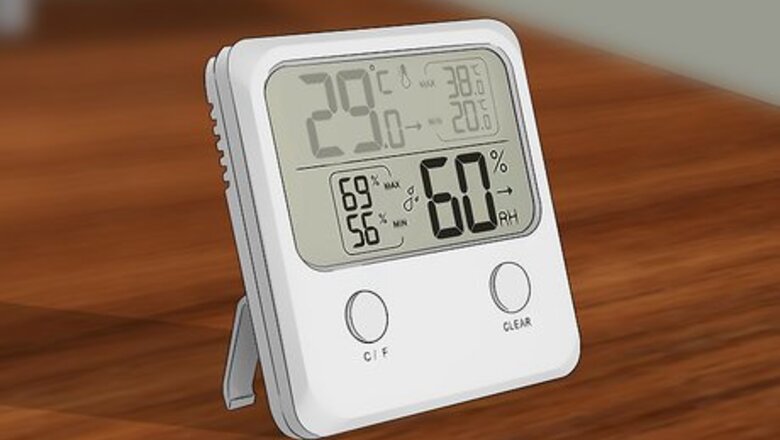
views
- Get a hygrometer for specific humidity readings, a wet/dry thermometer to measure humidity, or check windows for moisture and ceilings for mold.
- Run a dehumidifier, use exhaust fans, open a window (if the air outside is dry), keep doors closed, and take shorter showers to lower humidity.
- Run a humidifier, place a bowl of water close to a heating system, let your laundry air dry, and get houseplants to increase the humidity.
Measuring the Humidity
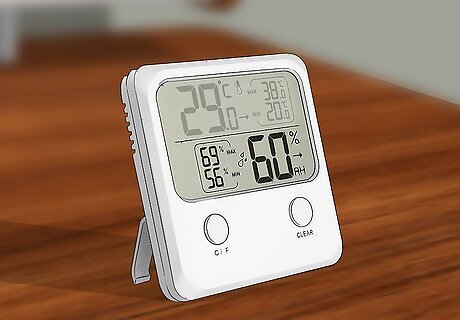
Invest in a hygrometer to get a specific humidity reading in any room. For rooms that need to be kept at a specific humidity, like a wine cellar or art studio, a hygrometer will give you the fastest, most accurate reading at any given time. Shop online or at your local home improvement store to find one that fits your budget. Install it in the room that needs to be monitored, and follow the hygrometer’s instructions to read it accurately. Generally, hygrometers cost anywhere from $10 to $40, just depending on the brand and its capabilities. To ensure you get an accurate reading, place your hygrometer away from your kitchen and bathrooms.
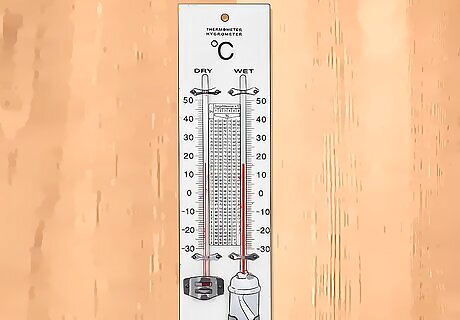
Use a wet/dry thermometer to manually determine the humidity level. You’ll need 2 thermometers, cotton gauze, rubber bands, and room-temperature water. Wrap a wet piece of cotton gauze around the bottom of one of the thermometers. Set the thermometers next to each other in the room in which you need to measure the humidity. Wait for 2 to 3 hours, then write down the temperature reading on each thermometer. Subtract the temperature from the wet thermometer from that of the dry thermometer—this is the humidity percentage for that room. The drier the air, the lower the temperature on the wet thermometer will be.
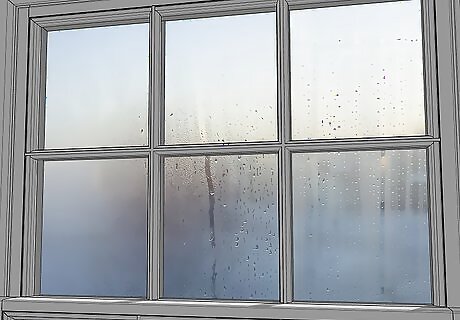
Observe the windows for moisture. If the windows in any given room are foggy, or if you can see condensation on the windows, that means that the humidity inside the room is at a high level. An excessive amount of humidity in a room will make the insides of the windows fog up, meaning that you’ll need to dehumidify the room to bring it back into balance. Think about when you shower and how the windows and mirrors will often be covered in steam when you get out. That’s because the level of moisture in the air greatly increased while the water was running due to the temperature of the water and the steam it produced. Also pay attention to moisture or wet stains on the walls or ceiling, as well as a stuffy feeling when you enter the room.
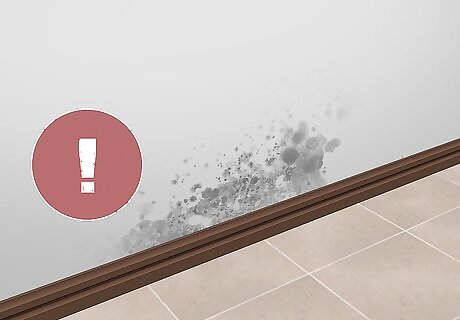
Check the walls and ceilings for the development of mold. This is a possible sign that a room is overly humid. Moisture in the air and on the walls isn’t able to evaporate fully, which creates a breeding ground for mold and other bacteria. A dehumidifier can help remove excess moisture from the room so you can deal with the mold and keep it from returning. You might also notice a musty odor in the room. Keep in mind that mold is sometimes caused by another source of water, like a leaky ceiling or faucet, and may not specifically be due to excessive humidity. If that’s the case, the leak needs to be addressed to fix the mold problem. The bathroom is a common place where you might notice mold developing. If this is the case, make sure to always use the exhaust fan when you shower to help filter out the humid air. If you don’t have an exhaust fan, leave a door or window open so the steam from the shower has somewhere else to go. The basement is another area where you might notice mold growth. Basements tend to be damp; to combat basement mold, run a dehumidifier to remove excess moisture from the air.

Pay attention to how much static you experience on a day-to-day basis. Especially in the colder months, you may start to run into excessive static due to a low level of humidity in your home. Run a humidifier to increase the level of moisture in the air to 45% to 50%. This should eliminate the static and make it easier for you to walk across carpet without getting shocked. When you change your sheets or make your bed and experience a lot of static, you’re also probably noticing that you’ve been waking up with a dry throat or that your skin has become dry. These are other signs that a room may need some extra humidity.Tip: If your skin is dry and you’re dealing with excessive static electricity, keep your skin moisturized. Apply lotion to your entire body after you shower, and rub it on your hands throughout the day.
Lowering the Humidity
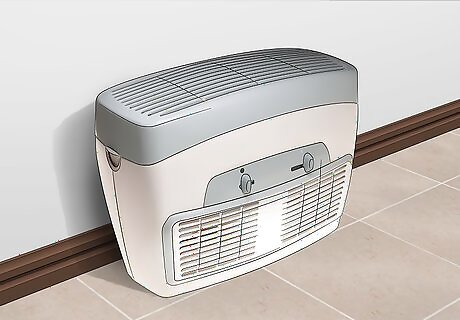
Run a dehumidifier to remove excess moisture from the air. This is the best way to control the humidity in a room, especially if that humidity level needs to be maintained regularly. When buying a dehumidifier, check the machine’s capabilities to ensure it will meet your needs: does it automatically turn on/off when the humidity level reaches a certain point; what is the capacity of the water basin and how often will it need to be emptied; does it come with an automatic defrost feature? For humidity-sensitive rooms, like wine cellars, art studios, or libraries, a dehumidifier with an adjustable humidistat is a great investment. You set the level of humidity needed, and the machine will automatically shut off or turn on when needed.
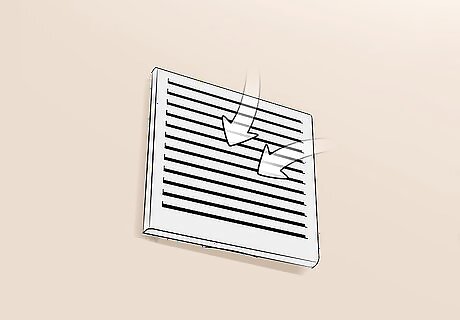
Use exhaust fans while cooking or doing other heat-producing activities. If the room you’re trying to control is in a common space, like the kitchen, living room, or bathroom, you can keep the humidity low with fans. Most stoves come equipped with exhaust fans, as do many bathrooms. These fans help filter out steamy air, which can quickly heat up a room. If you don’t have an exhaust fan where you need one, use a standing fan or a box fan—place it so that the air will be blown away from the room you’re in. Even just turning on a ceiling fan can help lower the humidity in a room, but it won’t have a great effect over a large amount of space. Using a ceiling fan to lower humidity will work best if the outdoor air is drier than the indoor air and if you can open windows to circulate the humid air from inside to the outside. The more enclosed a space (like in a bedroom with its doors closed), the more effective this will be.

Open a window if the air outside is less humid than it is inside. This is a simple method that can give you some quick relief when you’re working in a humid room. To determine the humidity level outside, it’s a great idea to use an outdoor humidity reader, because temperature on its own isn’t the best indicator of humidity levels. You can also often look online to get the current humidity reading for your particular area. If you leave your home, make sure to close the windows back up or use the security latches so your home isn’t at risk from intruders.Warning: Avoid opening the window if it’s drizzling or raining outside. The water could get into your home and contribute to the excessive humidity instead of helping solve it.
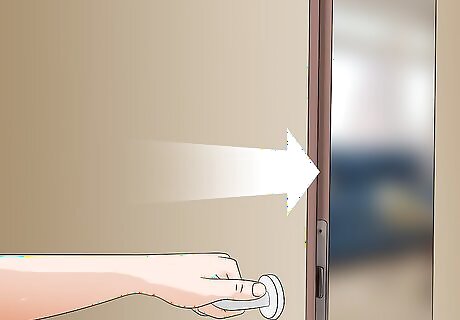
Keep doors closed to keep the humidity from other rooms out. Especially if you’re using a dehumidifier or a fan in one specific room, like a bathroom or the basement, it will help things run more efficiently if you keep the room closed off. The dehumidifier won’t have to work as hard to maintain the right level. If you have leaky windows or doors, get them fixed. That can also help keep a room at the right level of humidity. If you’re looking to dehumidify your entire home, it would be more advantageous to put the dehumidifier in a central location and keep all the interior doors in your home open. Depending on how large your space is, you may need more than one dehumidifier.
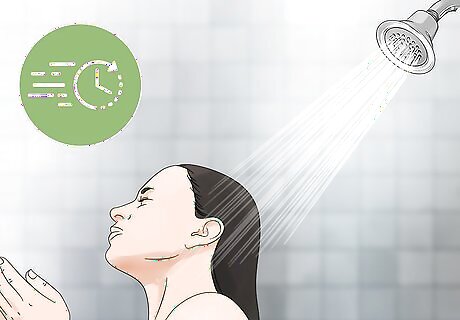
Take shorter, cooler showers to introduce less steam to the room. This will mainly effect the humidity in the bathroom and immediate surrounding areas. If you have a hard time showering in cold water, try making incremental changes to the temperature over time. For example, start your shower at your normal temperature, then halfway through, lower it so the water is lukewarm. At the end, turn the temperature down all the way and finish your shower with a few minutes of cold water. Taking shorter, cooler shower will not only help you maintain the humidity level in your bathroom, but it will also save you money on your water bill.
Increasing the Humidity
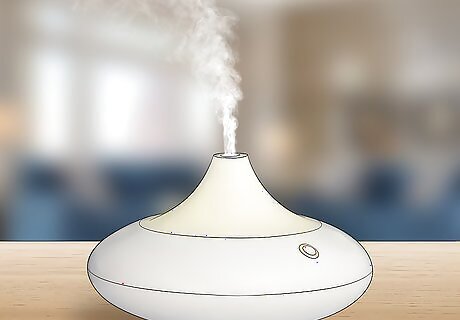
Run a humidifier to add more moisture to the air. Humidifiers are great for rooms that tend to run dry, which can especially become a problem in colder climates or during the cooler months. If you’re having problems with dry skin, dry sinuses, or static, try running a humidifier to introduce more moisture to the air. Change the water in your humidifier every 2 to 3 days, and clean it out twice a week so it doesn’t get moldy. Always read the humidifier’s manual before you use it. Some types require a specific kind of water, some will mist the air (in which case you don’t want to put it near fabric), while others might use cool or warm steam.Warning: Even if you don’t use your humidifier regularly, still clean it on at least a weekly basis. The water inside can cause mold to grow, even if the machine isn’t turned on.
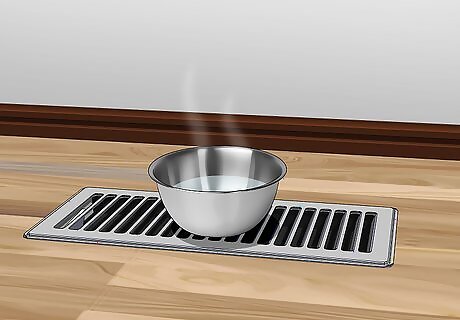
Place a bowl of water close to a heating system to create steam. Create your own makeshift humidifier if you don’t need to regularly decrease the humidity in a room. Fill a metal bowl with water and place it on top of a heating register or a floor vent. As the heat warms the bowl, it will create steam. The steam will add moisture to the air. Similarly, use a tea kettle to heat up water instead of a microwave to introduce more steam into the air. Never use a plastic bowl, as it might melt when placed on the heating register.

Let your laundry air dry instead of using the dryer. Not only will you save money on your energy bill, but you’ll also be adding extra moisture into the air. For example, if your bedroom is always dry, set up a drying rack and use it to dry your laundry. Keep the bedroom door closed to keep the new humidity in the bedroom. This won’t add a ton of moisture to the room, but it can make a definite difference for your comfort.
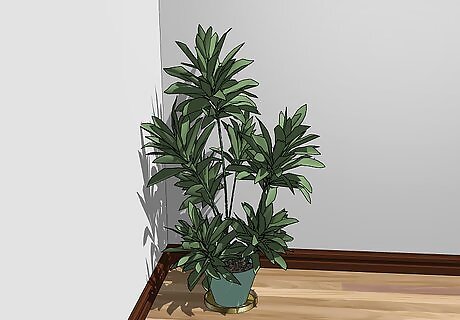
Add houseplants to the room to increase the moisture in the air. When plants transpire, the water that reaches the leaves evaporates into the air, which in turn increases the humidity. Plus, plants help remove air pollutants that can cause irritation. If you don’t have shelves or counter space to add plants, consider installing a hook from the ceiling so you can hang a plant. Look for these common houseplants to increase the humidity in your home: rubber plants, English ivy, spider plants, rubber figs, sword ferns, and peace lilies. On the flip side, if your home has excessive humidity and you own a lot of houseplants, consider removing some to help reduce the humidity level.




















Comments
0 comment